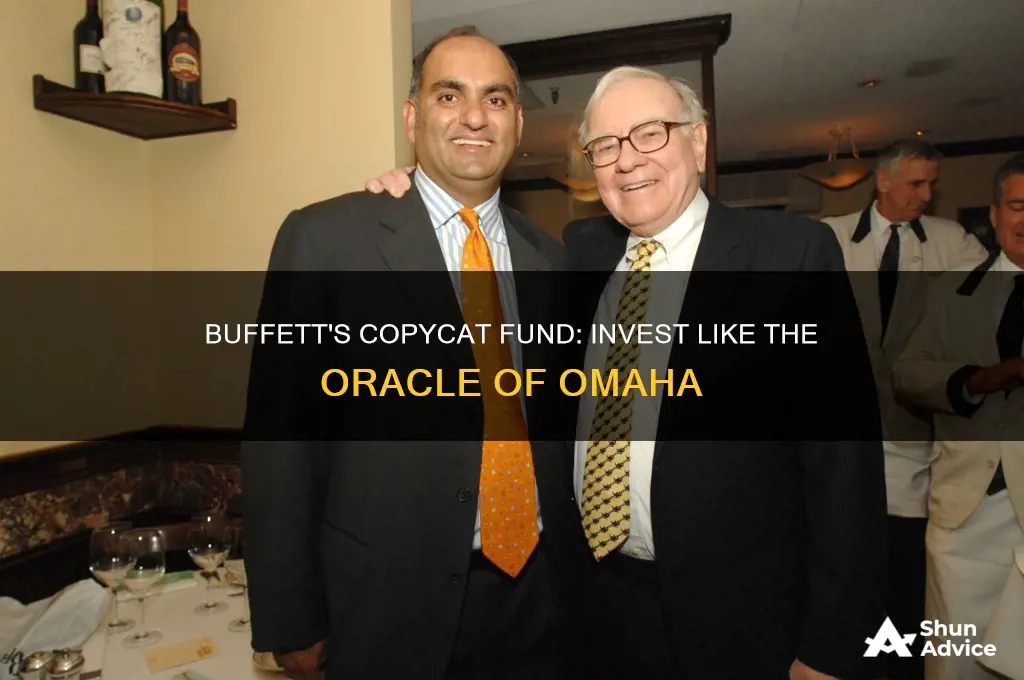
Copycat investing, also known as coattail investing, is a strategy that involves mimicking the trades of famous investors. One of the most emulated investors is Warren Buffett, the CEO and co-chair of Berkshire Hathaway, who is renowned for his investment approach and results.
Buffett's success is based on paying a fair price for quality businesses with an economic moat to protect them from competitors. He focuses on companies with strong brands, plenty of cash, and control over the pricing of their products.
While copycat investing has mixed results, there are techniques to increase your chances of success. Investors should exercise patience, conduct their own due diligence, and be aware of the risks, such as differing investment objectives and horizons.
To invest like Warren Buffett, here are some key principles to consider:
- Embrace market downturns as opportunities to buy valuable stocks at discounted prices.
- Focus on buying quality stocks at fair prices and holding them for the long term.
- Prioritise a margin of safety to protect against losses.
- Don't follow the crowd—make investment decisions independently.
- Understand the power of compounding and long-term investment.
- Be willing to sell if the scenario changes or the investment no longer aligns with your criteria.
| Characteristics | Values |
|---|---|
| Investment strategy | Coattail investing/copycat investing |
| Success | Mixed results |
| Best investors to copy | Successful money managers, buy-and-hold managers, and activist investors |
| Risks | Different investment objectives or horizons, stock has already moved |
| How to copy successfully | Patience, due diligence |
| How to find out what Berkshire Hathaway is invested in | Study the holdings listed in the company's Securities and Exchange Commission filing Form 13F |
| Berkshire Hathaway's market capitalization as of October 2023 | Over $763 billion |
| How to access Form 13F | Head to the SEC's Electronic Data Gathering, Analysis and Retrieval (EDGAR) site and search under a company name |
| How to know what stocks were bought and sold | Look for differences between a previous quarter's 13F and a current one |
| Tips for a coattail portfolio | Allocate shares properly, update your portfolio, take a page from the pros |
| Investment philosophy | Buy quality stocks at fair prices, focus on long-term ownership |
| How to maximize investment returns | Embrace market downturns, learn and apply value investing |
| Investment principles | Look for a margin of safety, focus on quality, don't follow the crowd, don't fear market crashes and corrections, approach investments with a long-term mindset, don't be afraid to sell if the scenario changes, learn the basics of value investing, understand compounding, research and reflect |
| Top holdings | Apple, Bank of America, Chevron, Coca-Cola, American Express |
What You'll Learn

Understand the basics of copycat investing
Copycat investing, also known as coattail investing, is a strategy that involves mimicking the investment ideas of famous investors or investment managers. It has gained popularity in recent years, with many investors attempting to replicate the success of legendary investor Warren Buffett. Here are the basics of copycat investing:
Understanding Copycat Investing
Copycat investing is the practice of emulating the investment strategies of successful investors, such as Warren Buffett. It involves studying the investment choices, techniques, and principles of these investors and applying them to one's own portfolio. This strategy is based on the assumption that following the strategies of proven investors will lead to similar investment success.
Choosing Whom to Copy
When considering a copycat strategy, it is crucial to select investors with a proven track record of success. These could include top mutual fund managers, well-known investors, or investment gurus like Warren Buffett. Investors can study the public filings of companies, such as SEC Form 13F, to identify the trades made by these successful investors.
Advantages of Copycat Investing
Copycat investing offers several benefits. Firstly, it allows individuals to learn from the best investors in the market and apply their strategies to their own portfolios. By replicating the investment choices of successful investors, copycats aim to achieve similar returns and minimise the risk of losing money. Additionally, copycat investing can save time and effort for those who do not have the expertise or time to conduct their own extensive research.
Risks and Challenges
However, it is important to recognise that copycat investing comes with certain risks and challenges. One of the key risks is that the copycat investor's objectives, time horizons, and risk tolerance may differ from those of the investor they are copying. Additionally, there may be a time lag between the actual trade and its reporting, which can impact the effectiveness of trade replication.
Due Diligence
To mitigate these risks, it is essential for copycat investors to conduct their own due diligence. While following the strategies of successful investors can provide guidance, it is crucial to ensure that each investment aligns with one's own investment goals, risk tolerance, and time horizon. Regular review and updates to the portfolio are also necessary to stay aligned with the chosen investor's strategies.
Common Investment Principles
When considering a copycat strategy, it is beneficial to understand the common investment principles that successful investors like Warren Buffett follow. These include buying quality stocks at fair prices, embracing market downturns as opportunities, focusing on long-term ownership, and applying value investing principles to identify underpriced companies.
Monthly Mutual Fund Investments: $50 Well Spent
You may want to see also

Learn how to identify quality companies
Warren Buffett is one of the world's richest people and is known for his successful investment strategies. Copycat investors try to replicate his success by mimicking his investments. Here are some of the ways you can identify quality companies to invest in, following Buffett's approach:
Consistent and Predictable Earnings
Buffett looks for companies with a consistent financial history and predictable earnings. He wants to be able to predict a company's future earnings power, which is not possible if the company's financials are obscure and non-transparent. Costco, one of Buffett's favourite companies, is a great example of this, with a five-star predictability rating and a 9.5% annual growth rate over the past decade.
Sustainable Competitive Advantage
Buffett looks for companies that are not only growing but also improving margins. This is often achieved through a sustainable competitive advantage, such as being perceived as a superior brand or having a macroeconomic advantage like cost leadership or access to unique technology. Apple, for instance, is considered both the strongest brand name and a world leader in tech innovation.
Capital Allocation Skill
Buffett places importance on the ability of a company's management to allocate capital wisely. He looks for managers who are skilled at deploying the company's capital through reinvesting in the business, making acquisitions, or returning value to shareholders through dividends or share buybacks. Ultimately, capital should be allocated for the long-term benefit of shareholders.
Low Capital Intensity
Companies with low capital intensity tend to perform better financially, as they often generate higher margins and are more resistant during economic downturns due to their reduced need for debt financing. Buffett's acquisition of See's Candies in 1972 is a prime example of this, as the company generated a 60% return on invested capital with relatively low capital expenditures.
Industry Dynamics
Buffett is known for his aversion to the airline industry, which he considers one of the worst sectors to invest in. However, he has also repeated his mistake of investing in this industry multiple times. When considering which industries to invest in, look for sectors with less intense competition and fewer bankruptcies.
By following these guidelines and studying Buffett's investment choices, you can learn to identify quality companies and make more informed investment decisions.
A Beginner's Guide to Index Fund Investing in India
You may want to see also

Learn how to identify undervalued companies
Warren Buffett is a legendary investor with a net worth of over $130 billion as of July 2024. He is known for his ability to identify undervalued stocks that turn out to be profitable in the long term. Here are some ways to learn how to identify undervalued companies, following the methods of Warren Buffett:
Understand the Basics of Value Investing
Warren Buffett is a follower of Benjamin Graham's school of value investing. Value investors look for companies with prices that are unjustifiably low based on their intrinsic worth. They search for stocks that are undervalued by the market or not recognised by other buyers. This requires an analysis of a company's fundamentals, such as its financial statements, earnings, revenues, and assets.
Focus on the Company, Not the Stock
Buffett looks at companies as a whole rather than the intricacies of the stock market. He chooses stocks based on the overall potential of a company. He focuses on companies with strong fundamentals, such as robust leadership, a competitive edge, and excellent products or services.
Assess Company Performance
Buffett looks for companies with a good return on equity (ROE) compared to their competitors over an extended period. He also considers the debt-to-equity ratio, preferring companies with minimal debt and earnings growth generated from shareholders' equity.
Evaluate Profit Margins
Buffett assesses companies' profit margins and their growth over time. He looks for companies with healthy, growing profit margins, indicating effective management of operating costs.
Look for Unique Products or Services
Buffett prefers companies with unique offerings that give them a competitive advantage. He tends to avoid companies whose products are easily substituted or rely heavily on commodities.
Find Discounted Shares
Buffett seeks out companies with strong fundamentals that are trading below their intrinsic value. He looks for quality stocks available at discounted prices.
Conduct Your Due Diligence
When considering an investment, it is essential to conduct thorough research. Review financial statements, study the industry, and assess the company's management team. Ensure the investment aligns with your risk tolerance and investment objectives.
By following these principles, you can develop a keen eye for identifying undervalued companies, just like Warren Buffett.
Strategies for Investing in PE Funds: A Comprehensive Guide
You may want to see also

Learn how to identify companies with growth potential
Warren Buffett is one of the world's most successful investors, amassing a fortune of over $130 billion as of July 2024. His investment strategy has attracted many copycats, and for good reason. Here are some tips on how to identify companies with growth potential, following the principles of Warren Buffett:
Understand the Business
Buffett's investment philosophy revolves around understanding the underlying business. He looks beyond the stock market intricacies and focuses on the company as a whole. This includes considering various factors such as company performance, debt, and profit margins. Buffett also prefers to invest in companies he can understand. He once passed on investing in Google and Amazon because he didn't have enough knowledge about the internet industry. Therefore, it is essential to educate yourself about the company and its industry before investing.
Look for Unique Products or Services
Buffett seeks companies with a competitive advantage, often stemming from unique products or services. He tends to avoid commodity-based firms, where price is the key differentiator. Instead, he looks for companies with consumer monopolies, where there is no effective competitor due to factors such as brand name, patents, or niche markets. These companies have higher profit margins and more predictable earnings.
Assess Company Performance
When evaluating a company's performance, Buffett looks at the return on equity (ROE) over an extended period, typically five to ten years. He compares this performance with that of rival companies in the same industry. A company that consistently outperforms its competitors indicates strong management and a solid business model.
Evaluate Profit Margins
Buffett also examines a company's profit margins to ensure they are healthy and growing. He looks for companies that can consistently increase their profit margins over time, indicating effective cost control and efficient operations.
Consider Undervalued Stocks
As a value investor, Buffett seeks out stocks that are undervalued relative to the company's intrinsic worth. He looks for quality companies with strong fundamentals that are trading below their true value. This approach requires a deep understanding of the company's financials and the ability to identify mispriced stocks.
Focus on Long-Term Growth
Buffett is a buy-and-hold investor, known for his long-term investment horizon. He is not interested in quick profits but instead seeks solid prospects for long-term growth. This strategy allows him to benefit from compound returns and avoid the costs associated with frequent trading.
In conclusion, Warren Buffett's success in identifying companies with growth potential lies in his disciplined approach to investing. He focuses on understanding the business, seeking unique products, assessing performance, evaluating profit margins, and finding undervalued stocks with long-term growth potential. By following these principles, investors can make more informed decisions and potentially achieve strong returns over time.
Vanguard Funds: Where to Invest Your Windfall
You may want to see also

Learn how to conduct your own due diligence
Copycat investing, also known as coattail investing, is a strategy that involves mimicking the trades of celebrity super-investors such as Warren Buffett. While this strategy has had mixed results, it has become increasingly popular in recent years.
When it comes to conducting your own due diligence, here are some key considerations:
- Understand the risks: Copycat investing carries certain risks. The investor you are copying may have different investment objectives or horizons, or the stock may have already moved by the time you learn about the investment. It is crucial to exercise patience and conduct thorough research before making any investment decisions.
- Follow credible and successful professionals: Stick with tried-and-tested money managers like Warren Buffett, who has a proven track record of success. Look for investors who follow a buy-and-hold strategy and have a long-term investment horizon.
- Look for accumulation: Focus on large-capitalization stocks that are experiencing difficulties but have potential for a turnaround. Identify stocks where money managers have started accumulating significant positions, indicating their confidence in the company's future prospects.
- Diversify your portfolio: Don't put all your eggs in one basket. Follow professionals from different sectors to diversify your copycat strategy. This will help reduce the risk associated with concentrating your investments in a single industry or sector.
- Conduct thorough research: Do your own due diligence and don't rely solely on the decisions of the investors you are copying. Evaluate each investment opportunity based on your own investment objectives, risk tolerance, and financial situation. Consider factors such as the company's business model, financial health, competitive advantage, and management team.
- Monitor your investments regularly: Even if you are following Warren Buffett's investment strategies, it is important to regularly review and adjust your portfolio. Stay updated with Berkshire Hathaway's SEC Form 13F filings to identify any changes in Buffett's holdings. Remember that investment conditions can change, and it is crucial to stay informed and make adjustments as necessary.
- Consider your risk tolerance and investment objectives: Ensure that the copycat stocks you are considering align with your risk tolerance and investment goals. Don't simply mimic another investor's moves without considering your own financial circumstances and comfort with risk.
By following these guidelines and conducting your own due diligence, you can make more informed investment decisions and potentially improve your chances of success when adopting a copycat investing strategy.
Investing in Mutual Funds for Minors: A Step-by-Step Guide
You may want to see also
Frequently asked questions
Copycat investing, also known as coattail investing, is an investment strategy where you replicate the investment ideas of famous investors or investment managers.
Copycat investing has its risks. For example, the investor you're copying may have different investment objectives or horizons, or the stock may have already moved by the time you make your investment.
US stock exchange rules require firms with more than $100 million in assets to disclose their top investments each quarter. You can find this information in the company's Securities and Exchange Commission filing Form 13F.







